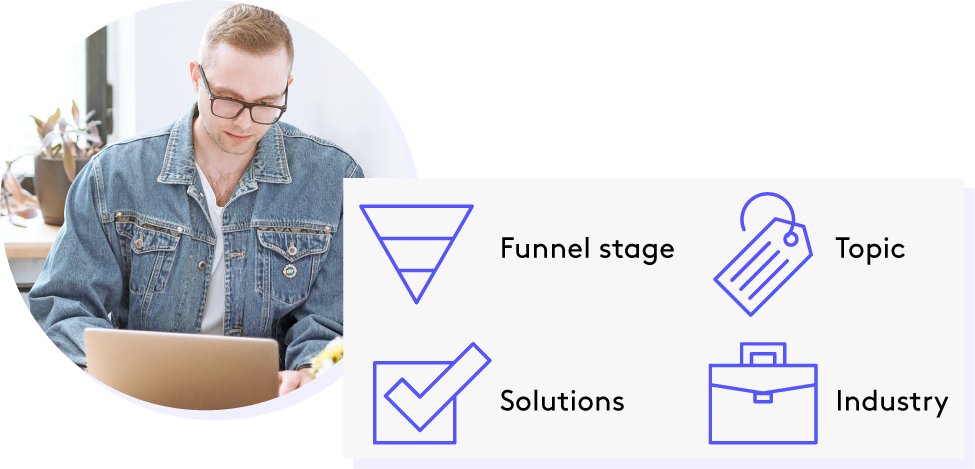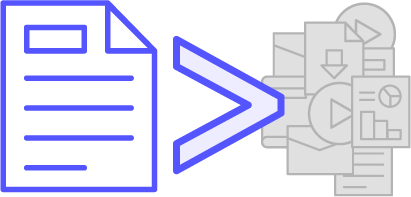
Three B2B revenue intelligence concepts that fuel better buyer journeys
I sat down with Rowan Noronha, founder of the Product Marketing Community, for a conversation about B2B marketing, content intelligence, and how it all ties back to revenue.
“Whether you’re a CMO, a CRO, or a product marketer, you’ll need revenue intelligence to make decisions. Without content intelligence and buyer intelligence, there is no revenue intelligence.”
– Rowan Noronha, founder of The Product Marketing Community
“Let the buyer buy” is a saying we often use at PathFactory to emphasize the importance of buyer enablement and creating frictionless content experiences for our audiences as they move through their journeys. When we provide content the buyer needs at the right time, they can make faster and more informed purchasing decisions.
In a recent B2B Visionaries webinar, Rowan Noronha shared three key concepts that help marketers put the right strategies and processes in place to support better buyer journeys:
- The three elements of a “WINning” product marketing strategy
- The five rings of insight that build audience intelligence
- How to reduce content waste and improve quality
Below, I’ve shared important highlights on these topics based on my conversation with Rowan. Make sure to watch the recording to get all the details.
The three elements of a WINning product marketing strategy
The W.i.N framework, which Rowan developed, helps us take the first step when engaging prospective buyers. Take an audience-first approach and consider the following before you start building content (or see it in action here).
Who: Decide who your best-fit customers are, who makes up the current and emerging competitors in your space, and what the status quo is. If you’re not sure how to get this information, start with call recordings, social media monitoring, and – most importantly – customer interviews.
Impact: Every product marketer needs to understand the value that their organization or solution provides to the best-fit customer. Can you communicate the impact and results your solution will create for your customers?
Narrative: Be sure you’ve crafted the right narrative, internally and externally, to engage your buyer. Audience-centric messaging based on buyer insights is crucial to building engaging content and high-performing programs.
The five rings of insight that build audience intelligence

Rowan really drove this point home: don’t start building content until you know exactly what your audience wants (and needs) to hear. Sounds simple enough, but many businesses make this mistake.
Rowan also spoke about The Buyer Persona Institute’s concept of the five rings of insight, which enable you to gather deeper information about your buyers. After you develop a basic understanding of your buyers (e.g. industry, funnel stage, current solutions, topics they’re interested in), you can move on to develop a deeper understanding of them using the following guidelines:
- Priority initiatives: Find out what your buyer’s priorities are. Why are they investing in your solution? What circumstances are causing the buyer to invest their time and money?
- Success factors: How is the buyer measuring success and what are they expecting from your solution?
- Perceived barriers: What’s preventing the buyer from considering your solution? How do you stack up against your competitors? Understanding this will help you develop your talk track.
- The buyer’s journey: What does the documented buyer journey look like? How is the buyer (or buying committee) making their final choice? How do they evaluate their options and eliminate contenders?
- Decision criteria: Understand your solution’s features that are being evaluated. How do your prospects prioritize them, and how do they compare to the competition?
Once you’ve collected this level of information about your audience, you’re ready to build content that speaks to them and their needs.
How to reduce content waste and improve quality

Only a very small portion of content being produced is actually valuable to sellers and buyers. It’s easy to get carried away with the quantity of the content being published, so have a disciplined approach to how you create quality content. To reduce content waste and maximize content value, Rowan recommends following his P.E.N framework for content creation (which he is in the midst of developing, so you’re getting a sneak peek!):
- Plan what you’re building, and who you’re building it for. Planning takes input, so ensure you’re in lockstep with the following groups:
- Internal and external audiences. This includes market segments, buyer & seller personas, as well as customers in the buyer journey and sales cycles. Work with product marketing to understand the messaging, topics, themes that will resonate with this audience.
- Campaign builders and teams that enable sales and customer success. Understand their campaign strategy and architecture. This group will remind you that a content’s distribution strategy is as important as the content you create.
- Subject matter experts from product, marketing, sales and customer success. This group will help decide the topics, themes, and messaging that will resonate with your internal and or external audiences.
- Execute: With the right audience-centric content strategy and inputs in place, you can go into execution mode. Align with your product marketing and campaign stakeholders, subject matter experts, writers, and designers as you design, build and deliver the content assets you’ll need to launch your campaigns or programs.
- Numbers: The numbers tell us what’s working (and what’s not working) as the campaigns are running. How is your content contributing to your pipeline, closed deals, and nurture programs? The data you get from your content engagement will be invaluable when you’re back at the planning stage for your next campaign.
Rowan’s main takeaway here is to remember to collaborate with those who build (i.e. product) and those who sell (i.e. marketing, enablement, sales, customer success) because this will increase your odds of turning your content assets into business assets – and that’s where the value is.
“We need to create content with the buyer top of mind, while also educating sales to have conversations on how the content hits the right message. Make sure you’re audience-centric, not sales centric.”
– Rowan Noronha, founder of The Product Marketing Community
Content intelligence and the AI, automation and analytics it uses can help you better understand what the right message is and how best to activate it with your audiences. Topics of interest technology in PathFactory, for example, uses natural language processing (NLP) to analyze content consumption patterns and helps marketers move beyond their own biases around what content will work best for audiences and how it should be tagged.
Humans aren’t that great at tagging. Content intelligence provides the data-driven insights we need to build audience-centric messaging and assets that align to topics that actually perform. To keep the buyer top of mind, while educating the sales team on what messaging and assets resonate best, B2B organizations need content intelligence.
If you’re ready to put these concepts into action, you can watch the webinar and browse through some = related resources here.

